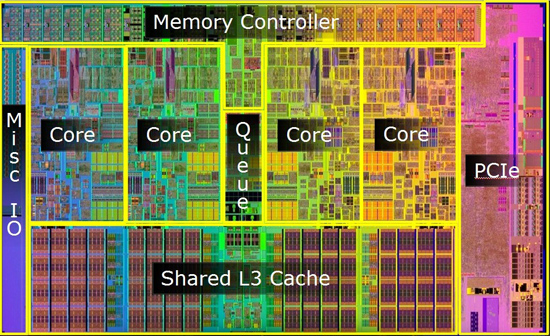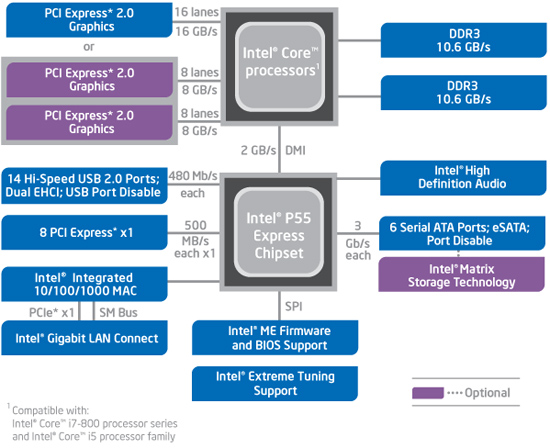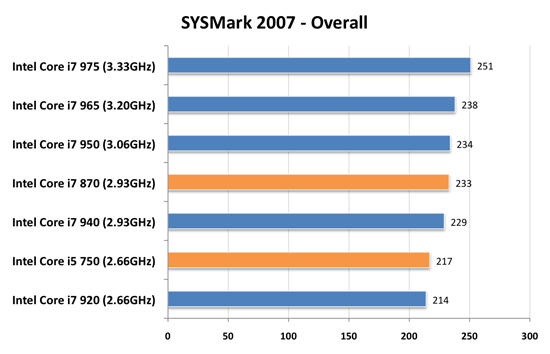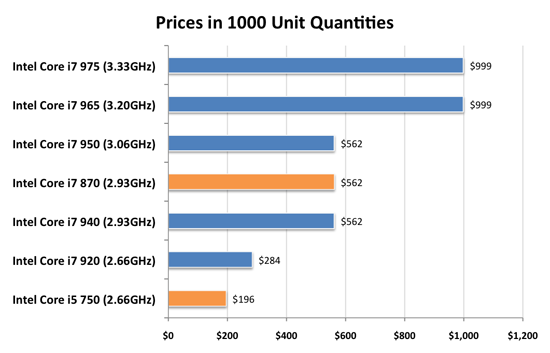Intel's Core i7 870 & i5 750, Lynnfield: Harder, Better, Faster Stronger
by Anand Lal Shimpi on September 8, 2009 12:00 AM EST- Posted in
- CPUs
Intel is on the verge of transitioning to 32nm. We'll see the first parts this year. What do you do with your 45nm fabs when you start moving volume away from them? Make really cheap quad-core Nehalems of course:

I'm talking $196. I'm talking faster than AMD's entire lineup. I'm talking about arguably the best processor of 2009. I'm talking about Lynnfield, and here's its backside:

Mmm
I spent much of the past year harping on AMD selling Nehalem-sized Phenom IIs for less than Intel sold Nehalems. With Lynnfield, Intel actually made Nehalem even bigger all while driving prices down. Like I said, what do you do when you're still making boatloads of money in a recession and are about to start emptying your 45nm fabs?
I should clear things up before we progress much further. Lynnfield is the codename for mainstream 45nm quad-core Nehalem, while Bloomfield refers to the first Nehalem launched at the end of 2008:
| Processor | Manufacturing Process | Die Size | Transistor Count | Socket |
| Bloomfield | 45nm | 263 mm2 | 731M | LGA-1366 |
| Lynnfield | 45nm | 296 mm2 | 774M | LGA-1156 |
Despite being cheaper, Lynnfield is larger than Bloomfield. The larger die is due to one major addition: an on-die PCIe controller.

Bloomfield, The First Nehalem, circa 2008

Lynnfield, Nehalem for All, circa 2009
The pink block to the right of the die is the PCIe controller, that's 16 PCIe 2.0 lanes coming right off the chip. Say hello to ultra low latency GPU communication. You'd think that Intel was about to enter the graphics market or something with a design like this.
Sacrifices were made to reduce CPU, socket and board complexity. Gone are the two QPI links that each provided 25.6GB/s of bandwidth to other CPUs or chips on the motherboard. We also lose one of the three 64-bit DDR3 memory channels, Lynnfield only has two like a normal processor (silly overachieving Bloomfield).

Intel's Bloomfield Platform (X58 + LGA-1366)
The sum is that Lynnfield is exclusively single-socket; there will be no LGA-1156 Skulltrail. While the dual-channel memory controller isn't really a limitation for quad-core parts, six and eight core designs may be better suited for LGA-1366.

Intel's Lynnfield Platform (P55 + LGA-1156)
The loss of QPI means that Lynnfield doesn't have a super fast connection to the rest of the system, but with an on-die PCIe controller it doesn't matter: the GPU is fed right off the CPU.
The Lineup
We get three Lynnfield CPUs today: the Core i7 870, Core i7 860 and the Core i5 750. Intel's branding folks told us that the naming would make sense one we saw the rest of the "Core" parts introduced; yeah that was pretty much a lie. At least there aren't any overlapping part numbers (e.g. Core i5 860 and Core i7 860).
The i7 in this case denotes four cores + Hyper Threading, the i5 means four cores but no Hyper Threading. The rules get more complicated as you bring notebooks into the fray but let's momentarily bask in marginal simplicity.
| Processor | Clock Speed | Cores / Threads | Maximum Single Core Turbo Frequency | TDP | Price |
| Intel Core i7-975 Extreme | 3.33GHz | 4 / 8 | 3.60GHz | 130W | $999 |
| Intel Core i7 965 Extreme | 3.20GHz | 4 / 8 | 3.46GHz | 130W | $999 |
| Intel Core i7 940 | 2.93GHz | 4 / 8 | 3.20GHz | 130W | $562 |
| Intel Core i7 920 | 2.66GHz | 4 / 8 | 2.93GHz | 130W | $284 |
| Intel Core i7 870 | 2.93GHz | 4 / 8 | 3.60GHz | 95W | $562 |
| Intel Core i7 860 | 2.80GHz | 4 / 8 | 3.46GHz | 95W | $284 |
| Intel Core i5 750 | 2.66GHz | 4 / 4 | 3.20GHz | 95W | $196 |
Keeping Hyper Threading off of the Core i5 is purely done to limit performance. There aren't any yield reasons why HT couldn't be enabled.
Intel was very careful with both pricing and performance of its Lynnfield processors. I'm going to go ahead and say it right now, there's no need for any LGA-1366 processors slower than a Core i7 965:

This is only one benchmark, but it's representative of what you're about to see. The Core i7 870 (LGA-1156) is as fast, if not faster, than every single LGA-1366 processor except for the ones that cost $999. Its pricing is competitive as well:

For $196 you're getting a processor that's faster than the Core i7 920. I'm not taking into account motherboard prices either, which are anywhere from $50 - $100 cheaper for LGA-1156 boards. I don't believe LGA-1366 is dead, but there's absolutely no reason to buy anything slower than a 965 if you're going that route.










343 Comments
View All Comments
erple2 - Tuesday, September 8, 2009 - link
[quoting]Not only did the feature that provided the least benefit (triple vs. dual channel) drive the reason for the socket/pin count difference, they gimp the platform with superior tech by cutting PCIE lanes in half[/quoting]
I thought that the X58 has the PCIe controller on the mobo, and the P55 doesn't? That the Lynnfield CPU's had a built-in PCIe controller, whereas the Bloomfields lacked the built-in PCIe controller? That appears to be another reason why intel had to make 2 separate sockets/platforms.
Now, whether that was made intentionally to force this issue with multiple platforms is a side issue (IMO). I don't necessarily think that it's a problem.
JonnyDough - Tuesday, September 8, 2009 - link
"Personally, from a consumer standpoint, I feel Intel botched the whole X58/P55 design and launch starting with the decision to go with 2 sockets. Not only did the feature that provided the least benefit (triple vs. dual channel) drive the reason for the socket/pin count difference, they gimp the platform with superior tech by cutting PCIE lanes in half."I believe it was intentional and not a botch. Intel was trying to separate a high and low end and to sell more chipsets. It's Intel being boss. It's what they do. Confuse the consumer, sell more crap, and hope that AMD stays a step behind. This is why we need AMD.
Intel is good at marketing and getting consumers to jump on the latest trend. Remember the Pentium 4? Why buy a lower ghz chip when the P4 clocks higher right?
The educated consumer waits and pounces when the price is right, not when the tech is new and seems "thrilling". This review is great but no offense it still almost seems to come with a "buy this" spin - which may be the only way a tech journalist can stay privy to getting new information ahead of the curve.
Comdrpopnfresh - Tuesday, September 8, 2009 - link
You purposefully placing the possibility of overclocking solely in the hands of the lower chip, while completely disregarding the history and facts. This-or-that logical fallacy. Third option: You can overclock the higher-clocked chip too.Granted, I see your point about the hardware being of the same generation of the architecture; that lynnnfield is not the tock to bloomfield's tick (or the other way around if how you hear clocks starts mid-cycle) and therefore the silicon has the same ceiling for OC.
But bloomfield is a like a D.I.N.K. household; dual-income-no-kids. When you overclock bloomfield, not only do you have the physical advantage of lower heat-density due to a large die, but you also don't have the whiny pci-e controller complaining how timmy at school doesn't have to be forced into overclocking. The on-die pci-e controller will hinder overclocking- period.
Just like trying to overclock cpu's in nearly identical s775 motherboards/systems. The system with the igp keeps the fsb from overclocking too much. So then what- you buy a dedicated gpu, negate your igp you spent good money on, just to have your cpu scream?
Except in this case, if one were able to disable the on-die pci-e controller and plop a gpu in a chipset-appointed slot (sticking with the igp mobo situation in s775) you'd be throwing away the money on the on-die goodies, and also throwing away the reduced latency it provides.
Has it occured to anyone that this is going to open an avenue for artificial price inflation of ddr-3. Now the same products will be sold in packages of 3's and 2's? Sorry- just figured I'd change the subject from your broken heard still stick on overclocking.
chizow - Tuesday, September 8, 2009 - link
Actually in the real world, overclockers are finding the 920 D0s clock as well and often better than the 965s for sure (being C0), and even the 975s D0. You're certainly not going to see a 5x proportionate return in MHz on the difference spent between a $200 920 and a $1000 975. There is no third option because their maximum clock thresholds are similar and limited by uarch and process. The only advantage the XE versions enjoy is multiplier flexibility, a completely artificial restriction imposed by Intel to justify a higher price tag.
philosofool - Tuesday, September 8, 2009 - link
Not seeing it dude. A little overvoltage and LGA 1156 overclocks with 1366.chizow - Tuesday, September 8, 2009 - link
Yes and early reports indicate they will overclock to equivalent clockspeeds, negating any Turbo benefit Lynnfield enjoys in the review. That leaves less subtle differences like multi-GPU performance where the X58 clearly shines and clearly outperfoms P55.puffpio - Tuesday, September 8, 2009 - link
In the article you refer to x264 as an alternative to h264in fact, h264 is just the standard (like jpeg or png) and x264 is an encoder that implements the standard. i wouldn't call it an alternative.
that would be like saying photoshop is an alternative to jpeg, becuase it can save in jpeg format
puffpio - Tuesday, September 8, 2009 - link
"You'd think that Intel was about to enter the graphics market or something with a design like this."dun dun dun! foreshadowing?
----
and since these parts consume less power yet are built on the same process, I assume they run at lower voltage? If so, since they ARE built on the same process, I'd assume they can survive the voltages of the original Bloomfield and beyond? eg for overclocking...
Anand Lal Shimpi - Tuesday, September 8, 2009 - link
Yes, Lynnfield shouldn't have a problem running at the same voltages as Bloomfield. The only unknown is the PCIe circuitry. I suspect that over time we'll figure out the tricks to properly overclocking Lynnfield.As far as Larrabee goes, I wouldn't expect much from the first generation. If Intel is *at all* competitive in gaming performance it'll be a win as far as they're concerned. It's Larrabee II and ultimately Larrabee III that you should be most interested in.
The on-die PCIe controller is a huge step forward though. CPU/GPU integration cometh.
Take care,
Anand
Comdrpopnfresh - Tuesday, September 8, 2009 - link
Have you seen bios implementations allowing for the controller to be disabled? Know if anyone intends to do this?